Frequently Asked Questions (FAQ)
The NZMATES logo is designed to represent cooperation between the people of Maluku and the people of Aotearoa New Zealand. The logo is made up of three symbols:
- A black koru forming a circle
- A red Nunusaku symbol in the middle
- A green ‘silver fern’ incorporated into the Z in ‘NZMATES’
The Koru symbol
The Te Ara Encyclopaedia of New Zealand defines the koru symbol as follows:
"The koru, which is often used in Māori art as a symbol of creation, is based on the shape of an unfurling fern frond. Its circular shape conveys the idea of perpetual movement, and its inward coil suggests a return to the point of origin. The koru therefore symbolises the way in which life both changes and stays the same."
The koru in the NZMATES logo represents a new beginning, but also growth, regeneration and a continuous cooperation that will continue to grow and evolve. The koru encircles the Nunusaku, intended to represent the support Aotearoa New Zealand is offering to Maluku to bring about new growth that will continue long into the future.
The Nunusaku symbol
The Nunusaku symbol represents the place from where all indigenous people in Maluku are said to originate. The symbol depicts the sacred Banyan tree, from which came the three trees that are said to have formed the three main rivers of Seram Island – Tala, Eti and Sapalewa. Nunusaku comes from Unu Nusa Asa Ku, meaning ‘The part of the island where I became one with Asa’, the origin or totality.
In the NZMATES logo, the Nunusaku represents the people of Maluku, who are at the centre of the logo and at the heart of the NZMATES programme. The Nunusaku also represents the natural resources of Seram Island and Maluku as a whole. Through renewable energy technology Maluku’s own abundant resources, such as sunlight and water, can be used to improve the prosperity and well-being of the people of Maluku.
The silver fern symbol
The silver fern (Cyathea dealbata), which is green on one side and silvery-white on the other, has come to be widely recognised as representing Aotearoa New Zealand and its people. The fern is endemic to New Zealand and was of significance to New Zealand’s indigenous Māori, and was also used by early generations of Aotearoa-born Europeans to differentiate themselves from their continental contemporaries. Today the fern is widely used in the logos of New Zealand government agencies (including the Ministry of Foreign Affairs and Trade), sports teams, businesses and community organisations.
In the NZMATES logo the silver fern provides an instantly recognisable visual link to Aotearoa New Zealand.
The logo colours
The red colour of the Nunusaku symbol is the same red used in the Mercy Corps Indonesia logo.
The green colour of the text ‘NZMATES’ is the same green used in Infratec’s logo.
Combining these colours is a visual representation of the collaboration of two different organisations, one Indonesian with a long history in Maluku, and one from New Zealand, working together towards a common purpose.
Logo designer
NZMATES would like to thank Mercy Corps Indonesia’s designer Diberu Karina, who designed the NZMATES logo.
NZMATES is funded by the New Zealand Ministry of Foreign Affairs and Trade (MFAT), and implemented through a three-way Partnership Arrangement with the Indonesian Ministry of Energy and Mineral Resources'Directorate General for New Renewable Energy and Energy Conservation (EBTKE) and the NationalElectricity Company (PLN) to jointly coordinate and provide direction for this programme. The programme is being delivered by New Zealand-based renewable energy company Infratec Ltd. and Yayasan Mercy Corps Indonesia.
For more information, see here.
The NZMATES Programme Management Office is located in Ambon, Maluku. NZMATES activities are spread throughout Maluku Province, in Eastern Indonesia.
For more information, see here.
From our programme management office in Ambon, NZMATES provides services, support, engagementand assistance, and work as a liaison and cooperation partner to PLN, EBTKE, and ESDM Dinas primarily. NZMATES’ interdisciplinary team of specialists provide support to these partners at all stages of the renewable energy project cycle, from resource assessments and feasibility studies, to engineering and operation and maintenance support. We also help develop tools, guidelines, and materials to support our partners, and others interested in building a vibrant renewable energy sector in Maluku.
NZMATES also collaborates with and supports other key stakeholders in Maluku’s renewable energy sector, like Pattimura University, Ambon State Polytechnic, BAPPEDA, Maluku’s Provincial Government, and District Governments. NZMATES also seeks to strengthen links between different institutions and actors working in the renewable energy space, as well as links with experts from New Zealand and elsewhere, providing information and access to resources, and creating partnerships and other synergies that allow new actors to flourish and increase the capacities in the renewable energy space.
For more information, see here.
In remote areas like Maluku, energy needs are currently met mostly through diesel generators. But getting diesel to these areas is expensive, unreliable and risky. Renewable technologies such as solar and hydro energy make use of resources that exist on site, avoiding the need to constantly bring fuel in from outside. Thus they represent a more reliable and affordable option in the long term for remote areas.
In addition, fossil fuels like diesel generate greenhouse gas emissions when they are burned, contributing to harmful climate change. The dangerous effects of climate change are already being felt around the world with higher average temperatures, sea level rise and stronger and more frequent extreme weather events like storms and floods. Renewable energy sources like solar, hydro and wind generate no emissions when they produce electricity, so allow communities to meet their electricity needs while minimising their contribution to climate change. In 2014 the Government of Indonesia set itself the target of generating 23% of its electricity from renewable sources by 2025. NZMATES shares the Government of Indonesia's commitment to renewable energy.
